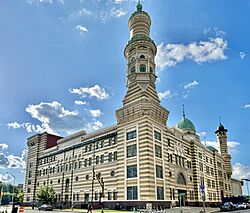Old National Centre facts for kids
|
Murat Theatre
|
|

Old National Centre in 2025
|
|
| Former names |
|
|---|---|
| Address | 502 N. New Jersey St. Indianapolis, Indiana United States |
| Coordinates | 39°46′27″N 86°9′4″W / 39.77417°N 86.15111°W |
| Owner | Murat Shriners of the Ancient Arabic Order of the Nobles of the Mystic Shrine |
| Operator | Live Nation |
| Capacity | 2,500 (Murat Theatre) 2,000 (Egyptian Room) 600 (Corinthian Hall) |
| Current use | music venue |
| Construction | |
| Opened | 1909 |
| Architect | Oscar D. Bohlen |
The Old National Centre is a famous building in Indianapolis, Indiana. It is located at North and New Jersey streets. This building was once known as the Murat Shrine Temple and the Murat Shrine Center.
The Murat Shriners, a group connected to the Ancient Arabic Order of the Nobles of the Mystic Shrine, own the building. The part of the building with a stage is now called the Murat Theatre at Old National Centre, or just the Murat Theatre. It has the oldest stage house still standing in downtown Indianapolis. This center is special because it is the only Shrine Center in the world with a French name. It is also the biggest Shrine Center in North America.
Contents
History of the Old National Centre
How the Murat Shrine Began
In 1882, five members of a group called the Freemasons wanted to start a Shrine organization in Indianapolis. They joined a Shrine Temple in Cincinnati, Ohio, which helped them create a new temple in Indianapolis. The local group, called the Indianapolis Shriners, officially started on June 4, 1884.
The first leader of the group was John T. Brush, who served from 1884 to 1897. Famous people like Lew Wallace and Thomas Taggart were among the first new members in 1885. By the end of its first year, the group had 105 members. The Indianapolis Valley of Scottish Rite gave them a building called the "Pork House" for their meetings.
Building the Murat Temple
The Murat Temple was built in 1909. The William P. Jungclaus Company constructed it, following designs by Oscar D. Bohlen, who was a Murat Shriner himself. The building's style included Middle Eastern and Egyptian looks, which fit well with the Shriners' traditions.
The building was named after Bir Murat, an oasis in the Nubian Desert. This oasis was named for Joachim Murat, a Frenchman who was one of Napoleon's generals during his campaign in Egypt.
Murat Shrine's Contributions
The Murat Shrine group has made some interesting contributions to Indianapolis. They gave the Indianapolis Zoo its very first camel. They also helped start the famous 500 Festival Parade, which is a big event in the city.
The Murat Theatre's Story
The Murat Shrine is most famous in Indianapolis for its theater, which was built in 1910. In its early days, the theater showed many Broadway plays. Even a famous leader, Winston Churchill, gave a speech there in 1932.
Between 1948 and 1963, the Murat Theatre was the only place in Indianapolis to see big traveling stage shows. Before Clowes Memorial Hall opened in 1963, the Indianapolis Symphony Orchestra performed there. The orchestra was able to survive the Great Depression because the Temple charged them very little to use the theater. The orchestra even made recordings with Fabien Sevitzky in the theater for RCA Victor from 1941 to 1953. The Indianapolis Opera Company also used the theater for a short time in the 1980s.
In 1984, the Murat Shriners had the second-largest number of members among all Shrine temples worldwide. In 1988, a fire happened in a part of the building added in 1968. Fifteen firefighters were hurt when a section of the addition fell. However, the main building did not suffer much damage.
Building Design and Features
The building's design looks like Moorish mosques found in the Middle East and Egypt. It has many special features. These include beautiful stained-glass windows and decorative terra cotta trim. You can also see minarets, which are tall towers often found on mosques. The building uses brown and yellow bricks in stripes.
A tall tower, about 208 feet high, stands at the southeast corner. An addition to the temple was designed to match the original building's look. The Egyptian-themed auditorium was planned before the famous discovery of Pharaoh Tutankhamun's tomb. This discovery happened around the same time the auditorium opened in 1922.
Event Spaces and Facilities
The Murat Shrine has several areas for events. The two main parts are a concert hall that can hold 2,000 people and a performing arts theater for 2,500 people. Today, there are nine different areas where events can be held.
The Egyptian Room can host 2,000 people for a standing party. Smaller areas include the Corinthian Hall, the Corinthian Annex, and the Corinthian Meeting Room. There is also the Great Hall and the Imperial Lounge, which used to be called the "Crowne Room." Various lobby areas are also available for events.
Concerts and Performances
The Old National Centre is a popular place for concerts. Many bands have performed there over the years. Some of these include Babymetal, Elle King, Huddy, Pennywise, Mitski, State Champs, and Sierra Ferrell.
See also
- List of music venues in the United States
- List of attractions and events in Indianapolis
- List of tallest buildings in Indianapolis#Other structures § Notes
- List of Masonic buildings in Indiana
- Moorish Revival architecture
- House of Blues

